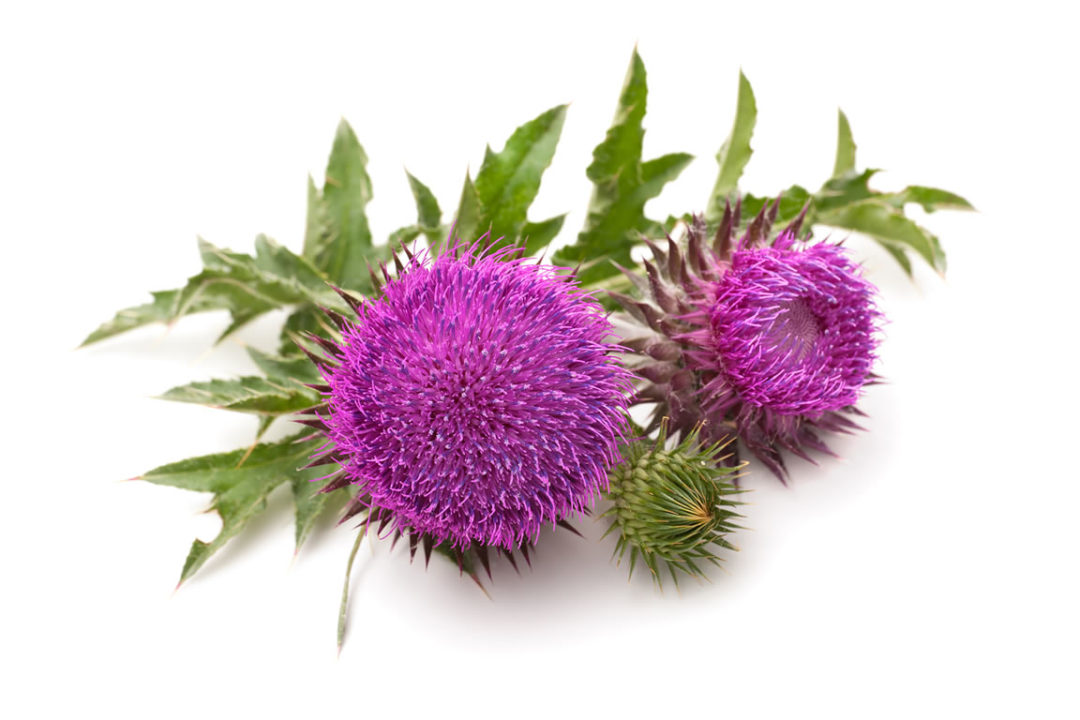Aloe Vera.Oral forms of Aloe vera are also included in many detoxifying methods due to the succulent plant's ability to support digestion, flush out bad bacteria and regularize bowel processing. According to an article in the Journal of Environmental Science and Health, aloe juice is able to work as a detoxifier because of its natural antibacterial, antifungal and antiviral properties. However, the University of Maryland Medical Center suggests certain aloe juices or aloe latex can cause painful cramping when ingested.
Milk Thistle.Silybum marianum, an herbaceous annual plant or biennial plant contains a flavonoid called silymarin, which has antioxidant and anti-inflammatory properties and is the active ingredient that supports the gall bladder, the kidneys and most importantly liver health (4).
Cascara Sagrada.The bark of cascara sagrada contains anthraquinone glycoside, which acts as a cathartic or laxative and can be used for colon problems linked with constipation (5). According to the University of Maryland Medical Center, cascara sagrada should only be used for a short period of time because it can cause dehydration.
Wild Burdock Root.While researchers are still trying to pin point the active ingredient, a study published in Inflammophrmacology in October 2011 found that the root of wild burdock was able to detoxify blood and promote blood circulation to the skin surface (6). Recent studies show that burdock contains phenolic acids, quercetin and luteolin which are all powerful antioxidants (7).
Dandelion.In a study published in Planta Medica, researchers testing for kynurenic, an amino acid that supports digestive and bile production, found dandelions to have the highest concentration of this compound, specifically located in its leaves (8).
Chlorella.When chlorella, a single-celled fresh water algae, is ingested into the body, its molecular structure bonds to metals, chemicals and some pesticides and helps the body to eliminate them (9).
Probiotics.Since the intestinal microbiome is the first line of defense to eliminate toxins from food, probiotics, which can be consumed through drinks, fermented foods such as yogurt and dietary supplements, not only balances the microbiome, but can also lower the amount of energy needed to digest food (10).
Activated charcoal.This is a treatment that traps toxins and chemicals. Although it is made from a variety of sources, for natural healing, it is best to select those that are made from coconut shells. Activated charcoal works to trap, then absorb toxins and chemicals through its porous surface, which has a negative electric charge that causes positive charged toxins and gas to bond with it (11).
Juicing.This is not only a popular cleansing method, but it is also an easy way to get lots of nutrients into the body. By juicing, all of the insoluble fiber that the body has to work hard to process is removed through the juicing process, which makes digestion a lot easier on the body (12). One important factor to keep in mind is juices have no protein. If shoppers are on a sole juicing regimen for a long period of time, the body can lose muscle mass, one’s metabolic rate and calories until solid foods that contain proteins are re-introduced (12).
Pros and Cons.After a detoxifying cleanse, many shoppers may find themselves with a high intake of vitamins and minerals, clearer skin, regular bowel movements and improved indigestion. However, each detoxifying cleanse can also have potential temporary side effects such as frequent bowel movements, little energy, and even a disruption of one’s blood glucose levels (13).WF
Published in WholeFoods Magazine December 2016
References
- M. Hyman, “Detox Made Safe and Simple,” Nov. 12, 2012, http://www.doctoroz.com/article/detox-made-safe-and-simple, accessed Oct. 31, 2016.
- A. Nakayama, “What’s the Difference Between Detox and Cleanse?” Sept. 28, 2016, http://www.replenishpdx.com/2016/09/detox-cleanse-whats-the-diff/, accessed Oct. 31, 2016.
- University of Maryland Medical Center, “Psyllium,” Oct. 19, 2015, http://umm.edu/health/medical/altmed/supplement/psyllium, accessed Oct. 31, 2016.
- M. Lam, “Liver Cleansing Herbs: Milk Thistle Benefits Aid Detoxification,” https://www.drlam.com/blog/liver-cleansing-herbs-milk-thistle-detox/18381/, accessed Oct. 31, 2016
- University of Rochester Medical Center, “Cascare Sagrada,” https://www.urmc.rochester.edu/encyclopedia/content.aspx?contenttypeid=19&contentid=CascaraSagrada, accessed Oct. 31, 2016
- Y.S. Chang, et al., “A Review of the Pharmacological Effects of Arctium lappa (burdock),” Inflammopharmacology. 19 (5): 245-54. (2011) Available at https://www.ncbi.nlm.nih.gov/pubmed/20981575, accessed Oct. 31, 2016.
- University of Maryland Medical Center, “Burdock,” June. 22, 2015, http://umm.edu/health/medical/altmed/herb/burdock, accessed Oct. 31, 2016.
- M.P. Turski, at al., “Distribution, Synthesis, and Absorption of Kynurenic Acid in Plants,” Planta Medica. 77 (8): 858-64. (2011) Available at https://www.ncbi.nlm.nih.gov/pubmed/21157681, accessed Oct. 31, 2016.
- J. Mercola, “Chlorella: Use This Superfood to Help Remove Mercury From Your Tissues in Weeks,” Feb. 1, 2012, http://articles.mercola.com/sites/articles/archive/2012/02/01/is-this-one-of-natures-most-powerful-detoxification-tools.aspx, accessed, Oct. 31, 2016.
- A. Junger, “The 3-Day Jumpstart Cleanse,” April 29, 2013, http://www.doctoroz.com/article/3-day-jumpstart-cleanse, accessed Oct. 31, 2016.
- J. Axe, “Top 10 Activated Charcoal Uses & Benefits,” https://draxe.com/activated-charcoal-uses/, accessed Oct. 31, 2016.
- J. Axe, “Juice Cleanse: The Pros & Cons of a Juicing Diet,” https://draxe.com/juice-cleanse/, accessed Oct. 31, 2016.
- Cleveland Clinic, “Are You Planning a Cleanse or Detox? Read This First,” Oct. 30, 2014, https://health.clevelandclinic.org/2014/10/are-you-planning-a-cleanse-or-detox-read-this-first/, accessed Oct. 31, 2016.










